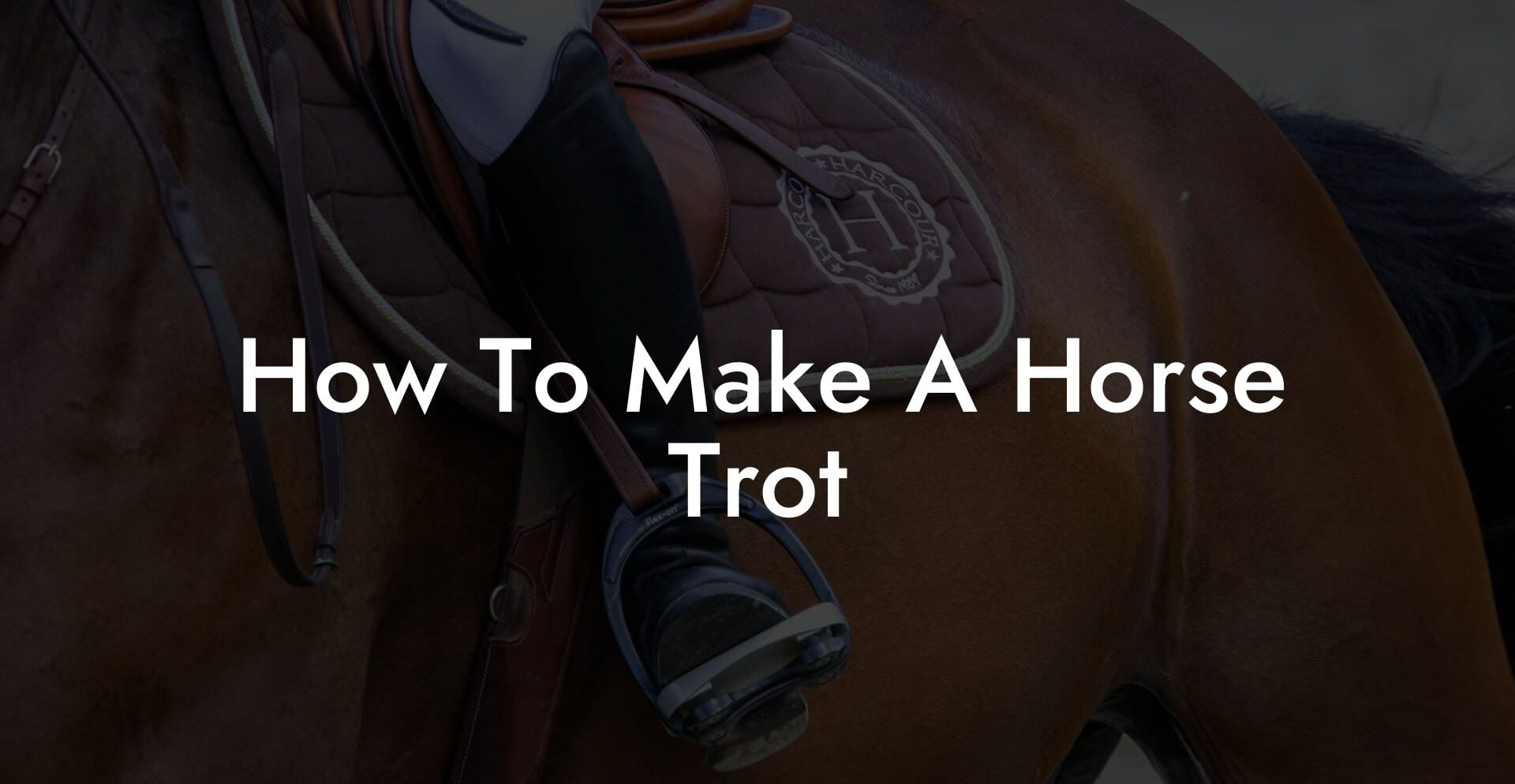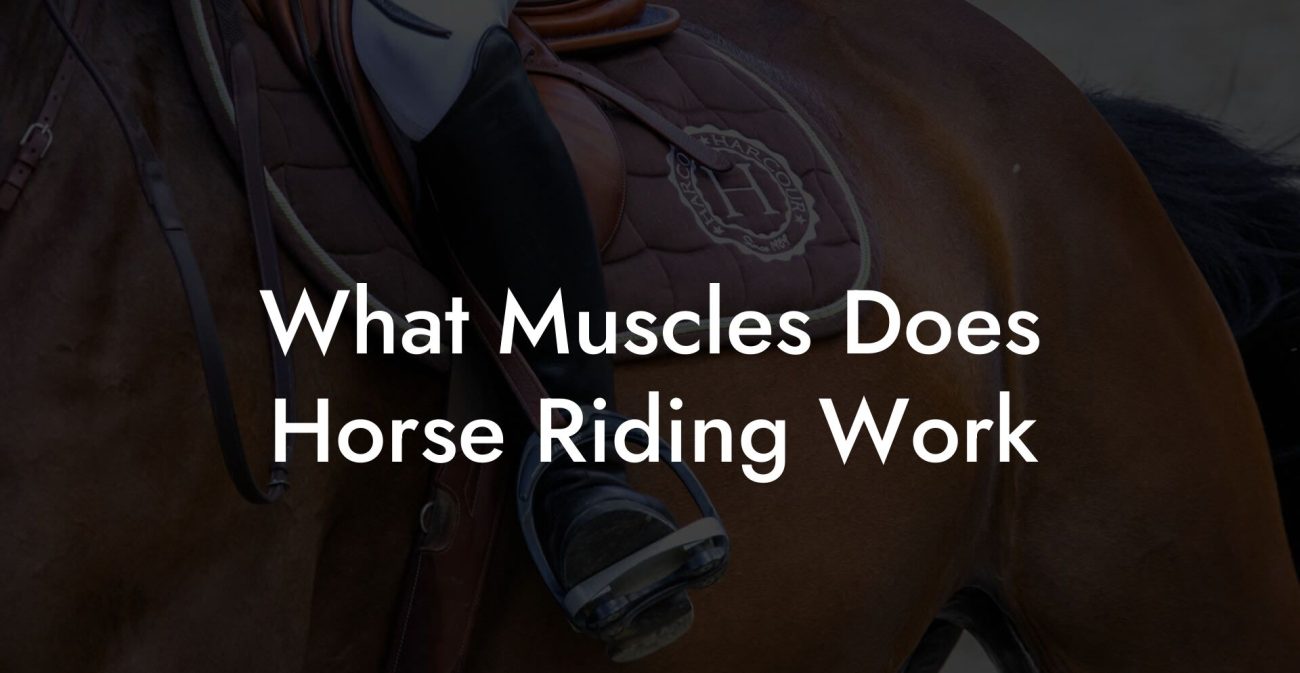Ever wondered how to get your majestic steed to trot like it’s auditioning for a Zumba class? Buckle up, saddle up, and prepare to transform your horse into the equine equivalent of a trending dance move. In this powerhouse guide, we’ll dive into the art, science, and downright fun techniques of how to make a horse trot. Whether you’re a millennial equestrian enthusiast or a Gen-Z rider just starting out, you’re about to discover a treasure trove of tips, tricks, and insider secrets that blend classic horsemanship with modern training hacks.
Quick Links to Useful Sections
- Understanding the Trot: The Heartbeat of Equine Movement
- Why a Great Trot Matters: The Science and Soul Behind Equine Movement
- The Biomechanics of a Horse Trot: Movement, Muscle, and Magic
- The Impact Phase
- The Suspension Phase
- The Recovery Phase
- Preparing Your Horse for a Trot: The Essential Warm-Up
- Step 1: A Gentle Walk
- Step 2: Early Stretching Routines
- Step 3: Transition to a Trot
- Training Techniques: How To Make A Horse Trot Like a Pro
- 1. Consistent Repetition
- 2. Positive Reinforcement
- 3. Varying the Terrain
- 4. Incorporate Pattern Drills
- 5. Use Visual and Verbal Cues
- nutrition and Care: Fueling Your Horse’s Trot Transformation
- High-Quality Forage and Grains
- Hydration is Key
- Regular Health Checks and grooming
- Holistic and Integrative Approaches to Enhance Your Horse’s Trot
- Mind-Body Connection for Your Equine Companion
- Acupuncture and Massage Therapy
- Natural Supplements and Herbal Remedies
- Modern Technology: Harnessing Digital Tools to Perfect the Trot
- Wearable Sensors for Real-Time Feedback
- Horse Training Apps
- Video Analysis and Social Media Integration
- Case Studies: Transformative Journeys to the Perfect Trot
- Case Study 1: From Sluggish Strides to Snappy Trot
- Case Study 2: Bridging Traditional Methods with High-Tech Tools
- Case Study 3: The Holistic Revival
- Resources and Community Support: Your Next Steps on the Trot Journey
- Online Forums and Social Media Groups
- Workshops and Clinician Seminars
- Local Riding Clubs and Equestrian Centers
- Digital Tools and Mobile Apps
- FAQ: Your Horse Trot Questions Answered
- Your Journey to Mastering the Horse Trot: Get Ready to Ride the Rhythm
Understanding the Trot: The Heartbeat of Equine Movement
The trot is more than just a step – it’s the heartbeat of a horse’s gait. Picture it as the groove that propels your four-legged friend forward with grace, rhythm, and a hint of rebellious attitude. The trot is naturally comfortable for horses, offering a balanced pace for long rides, show jumping, and even some casual countryside cruising.
When we talk about “how to make a horse trot,” we’re diving into not just physical training, but also the art of communication, understanding body language, and establishing trust between you and your horse. It’s about teaching your animal friend to move with a lively bounce that signals excitement, readiness, and impeccable balance.
In this guide, we’ll cover everything from the basics of trotting mechanics and the importance of proper warm-ups to advanced training techniques that channel both the playful energy of Gen-Z and the precision beloved by die-hard equestrians. From established horse care practices to modern equine training hacks, consider this your one-stop-shop for everything trot-related.
Why a Great Trot Matters: The Science and Soul Behind Equine Movement
At first glance, a trot might seem like just another gait, but it holds a very special place in the world of equine movement. A well-executed trot is a testament to balanced muscle use, enhanced endurance, and the horse’s ability to blend power with poise. For riders, a smooth trot means improved control, a more comfortable ride, and a connection with the animal that makes every journey feel like a well-choreographed performance.
On a biomechanical level, trotting synchronizes the horse’s limbs in diagonal pairs, a natural rhythm that minimizes fatigue and maximizes forward momentum. This rhythm isn’t only aesthetically pleasing, it’s essential for preventing injuries and ensuring long-term equine health. When a horse trots correctly, every stride is a harmonious blend of muscle coordination, balance, and energy conservation.
For riders, especially those who value a mix of classic horsemanship and modern training insights, mastering the trot means more than just learning a beat. It opens up the door to advanced riding skills, sharper reflexes, and the ability to navigate any terrain with confidence. In essence, a great trot is the foundation for everything from competitive dressage to casual trail riding.
The Biomechanics of a Horse Trot: Movement, Muscle, and Magic
Let’s break it down: What exactly happens when your horse trots? At its core, the trot is characterized by a two-beat rhythm, where the horse’s legs pair up in diagonal pairs (front left with rear right, and vice versa). Each beat represents a distinct phase of impact, suspension, and recovery.
The Impact Phase
This is the moment when your horse’s hoof makes initial contact with the ground. A proper trotter ensures that this impact is soft yet rhythmic, absorbing shock like a pair of high-tech sneakers cushioning your first step out of bed. The goal here is to minimize strain on the joints, keeping everything moving smoothly.
The Suspension Phase
Between the beats, there’s a brief moment when all four hooves are off the ground. This “suspended” phase is where gravity meets grace. Your horse isn’t just leaping, it’s suspending in mid-air with an elegance that would make any Instagram influencer jealous. It’s the ultimate display of power and poise.
The Recovery Phase
Finally, as the next pair of hooves is about to make contact, the recovery phase begins. This transition is crucial in maintaining balance and preparing the next impactful beat. Think of it as your horse’s way of recovering after a sprint, breathing in deeply before launching into another stride.
By understanding these biomechanical components, you can better appreciate how each stride contributes to a fluid and efficient trot. Optimizing these phases not only improves your horse’s performance but also reduces the risk of injuries associated with uneven or poorly executed gaits.
Preparing Your Horse for a Trot: The Essential Warm-Up
Just like that pre-workout playlist that gets you hyped up before hitting the gym, a proper warm-up is essential for your horse before implementing trot training. Warming up does more than just loosen muscles, it signals your horse mentally that it’s time to shift gears and get into the zone.
Step 1: A Gentle Walk
Begin with a gentle walk around the stable or arena. This not only warms up the horse’s muscles, but it also provides an opportunity to check for any signs of discomfort or stiffness. Keep it casual, your horse isn’t auditioning for a sprint just yet.
Step 2: Early Stretching Routines
Incorporate some basic stretching exercises. Think of it as your equine equivalent of a dynamic yoga session. Light lunging or simple guides to stretch the legs and back help to lubricate the joints and prepare the muscles for more rigorous work.
Step 3: Transition to a Trot
Once the horse’s muscles are warmed up, gradually transition into the trot. Start slowly, allowing the horse to find its natural rhythm. Maintain a relaxed rein and avoid pushing too hard; remember, quality is more important than speed.
This warm-up routine not only gears up the horse’s body but also reinforces your role as a thoughtful and caring trainer. It sets the stage for a productive training session, ensuring that the trot is executed with poise and confidence.
Training Techniques: How To Make A Horse Trot Like a Pro
Ready to dive into the nitty-gritty of trot training? Below are a few tried-and-true methods that blend traditional techniques with modern, meme-worthy training hacks that even the most tech-savvy riders can appreciate.
1. Consistent Repetition
Repetition is the name of the game. Just as a catchy TikTok dance trend takes time to master, so does the perfect horse trot. Daily practice sessions, even if they’re short, can help reinforce muscle memory and improve overall performance.
2. Positive Reinforcement
Forget the old “whip and shout” method, modern horsemanship embraces positive reinforcement. Use treats, gentle pats, and soothing words to reward your horse every time it nails a smooth, rhythmic trot. Your horse isn’t just training; it’s learning to love the process.
3. Varying the Terrain
Mix up your training sessions by trotting on different surfaces. From soft sand on the beach to a smooth indoor arena floor, varying the terrain challenges your horse’s balance and coordination, ensuring that the trot remains efficient regardless of the environment.
4. Incorporate Pattern Drills
Introduce drills that involve simple obstacles or changes of pace. For example, have your horse trot around cones, navigate a figure-eight pattern, or even incorporate slight turns. These drills not only build agility but also keep your training sessions interesting and engaging.
5. Use Visual and Verbal Cues
Your body language is a powerful tool when communicating with your horse. Use clear visual signals, like a subtle nod of your head or a shift in your stance, along with consistent verbal commands to indicate when it’s time to pick up the pace or adjust its stride.
With these training techniques, you’re not just teaching your horse to trot; you’re creating a dynamic partnership built on trust, consistency, and a shared sense of humor. And remember, progress might be gradual, but every small win is a victory worth celebrating.
nutrition and Care: Fueling Your Horse’s Trot Transformation
Just like a smartphone needs the perfect operating system update, your horse requires the right nutrition and care to perform at its peak. A well-balanced diet and consistent care routines are key ingredients in ensuring that your horse can trot with the energy and resilience of a champion.
High-Quality Forage and Grains
At the foundation of any equine diet is high-quality forage, think premium hay and pasture grazing. Add in the right mix of grains and supplements tailored to your horse’s energy needs, and you’ve got a recipe for success. Our SEO queue here includes keywords like “premium horse feed,” “balanced equine diet,” and “nutritional horse care.”
Hydration is Key
With hard work comes the need for plenty of water. Ensure your horse always has access to clean, fresh water. Hydration affects everything from muscle performance to overall health, so never underestimate the power of a well-hydrated horse.
Regular Health Checks and grooming
A smooth trot is not just about training; it’s also about preventative care. Regular health checks, dental care, and even chiropractic adjustments for horses help maintain muscle tone and skeletal alignment. Grooming sessions, which double as quality bonding time, keep your horse’s coat shiny and muscles relaxed.
Combining proper nutrition with regular veterinary check-ups creates a robust foundation for long-term health. With optimal care, your horse is more likely to develop and maintain a healthy, efficient trot that looks and feels fantastic.
Holistic and Integrative Approaches to Enhance Your Horse’s Trot
In today’s world, a holistic approach to equine training blends the best of both traditional horse care and modern wellness techniques. It’s about looking beyond the physical mechanics and embracing a mindset where every aspect of your horse’s well-being is nurtured.
Mind-Body Connection for Your Equine Companion
Much like humans, horses can benefit immensely from a focus on mental well-being. Incorporate moments of calm and relaxation into your training sessions. Simple techniques such as slow, deliberate movements and quiet moments in the pasture can help your horse feel relaxed and focused before engaging in more intense training.
Acupuncture and Massage Therapy
While it might sound like something out of a wellness retreat brochure, acupuncture and equine massage have gained traction among modern horse trainers. These therapies can relieve muscle tension, reduce stress, and optimize blood circulation, facilitating a smoother, more powerful trot.
Natural Supplements and Herbal Remedies
Integrate natural supplements, such as omega-3 fatty acids, herbal blends, and antioxidants, into your horse’s diet. These supplements not only support muscle recovery but also combat inflammation, ensuring that every trot is executed with a spring in the step and minimal discomfort.
By marrying holistic practices with proven training methods, you’re treating your horse like the superstar it is. Your approach becomes a collaborative journey of nurturing both physical performance and emotional wellness, ensuring that every trot is a work of art.
Modern Technology: Harnessing Digital Tools to Perfect the Trot
The digital age is your friend, even in the realm of equine training. From wearable tech and smart saddle systems to mobile apps that monitor progress, technology can provide insights that were once out of reach for traditional trainers.
Wearable Sensors for Real-Time Feedback
Imagine having a Fitbit for your horse. Wearable sensors attached to your horse’s girth or legs can track stride length, heart rate, and even travel patterns. This real-time feedback allows you to assess performance immediately and make adjustments on the fly.
Horse Training Apps
Several mobile apps are now available that log training sessions, set reminders for feeding and grooming, and even provide tutorials on improving gait. These tools are perfect for the tech-savvy rider who wants data-driven insights without sacrificing a fun training vibe.
Video Analysis and Social Media Integration
Record your training sessions and use video analysis software to break down each part of the trot. Compare videos side-by-side to observe subtle nuances or imperfections. Plus, sharing your progress on social media isn’t just a bragging right, it’s a way to join a community of like-minded riders who can offer advice, motivation, and support.
Modern technology transforms the art of trot training into a sophisticated, interactive process that aligns perfectly with the digital lifestyles of Gen-Z and millennial riders.
Case Studies: Transformative Journeys to the Perfect Trot
Let’s hit pause on the technical talk and delve into real-life success stories. Meet riders who revolutionized their approach to trot training, embracing both tradition and innovation to help their horses reach new heights.
Case Study 1: From Sluggish Strides to Snappy Trot
Jessica, a young rider known for her viral equestrian TikTok routines, struggled with a horse that had a habit of dragging its feet. By combining a revamped nutrition plan, consistent warm-ups, and advanced video analysis techniques, she transformed her horse’s gait. The once sluggish trot became as rhythmic as a well-edited remix, earning her followers’ applause and a spot on local competition circuits.
Case Study 2: Bridging Traditional Methods with High-Tech Tools
Aaron, a millennial rider with an affinity for both classic riding and the latest gadgets, decided to integrate wearable sensors and horse training apps into his regimen. His thorough data tracking revealed subtle imbalances in his horse’s gait, which he corrected through targeted physical therapy and mindful training sessions. The result? A graceful, balanced trot that not only boosted his horse’s performance but also earned him accolades from both veterinarians and digital communities.
Case Study 3: The Holistic Revival
When Emily noticed her horse was prone to muscle stiffness and stress-related behaviors, she took a holistic approach combining acupuncture, massage therapy, and a tailored diet rich in natural supplements. Over time, her horse’s movements became noticeably lighter and more confident. What began as a struggle turned into a demonstration of how integrative health practices can revitalize an animal that seemed stuck in a rut. Emily’s journey is a testament to the power of viewing equine care as a complete lifestyle.
These case studies highlight that whether you lean towards high-tech innovation or time-honored holistic care (or a cunning blend of both), the road to mastering the perfect horse trot is paved with dedication, creativity, and a willingness to experiment.
Resources and Community Support: Your Next Steps on the Trot Journey
Diving into the world of equine training can feel overwhelming, but remember: you’re not in this alone. The community of modern horsemanship is as diverse and vibrant as it is supportive. Here are some resources and communities to connect with as you hone your horse trotting expertise:
Online Forums and Social Media Groups
Platforms like Reddit’s r/equestrian, specialized Facebook groups, and Instagram communities are excellent places to ask questions, share progress, and get inspired by fellow riders. These spaces are fertile ground for exchanging tips on everything from horse care and nutrition to the latest in digital training tools.
Workshops and Clinician Seminars
Many equestrian centers and veterinarians now offer hands-on workshops that detail the latest in trot training techniques and horse care. Whether it’s a weekend retreat or a one-day seminar, these events provide invaluable opportunities to learn from experts and still enjoy some fun, practical, and humorous horse antics.
Local Riding Clubs and Equestrian Centers
Nothing beats the support of a local riding community. Find a club near you to join group lessons, practice sessions, and even equine therapy classes where you can observe different training styles and interact face-to-face with enthusiasts who share your passion.
Digital Tools and Mobile Apps
Leverage technology with apps that track training sessions, log dietary plans, and even suggest corrective measures after a video analysis. These tools are particularly great for riders who crave a data-centric approach to their horse’s performance.
Embracing these resources will not only sharpen your training skills but will also instill a sense of community, making the journey to mastering the perfect trot both educational and entertaining.
FAQ: Your Horse Trot Questions Answered
From the basics of hanlding your horse to sophisticated training techniques, here are some frequently asked questions designed to help you along your journey.
1. What exactly is a horse trot and why is it important?
A horse trot is a two-beat gait where diagonal pairs of legs move in unison. It is important because it ensures an efficient, balanced, and comfortable ride while promoting the horse’s long-term musculoskeletal health.
2. How long does it take for a horse to naturally develop a good trot?
The time varies based on the horse’s age, fitness level, and previous training. With consistent practice and proper care, noticeable improvements can occur within a few weeks to a few months.
3. Can I train my horse to trot if it currently resists?
Yes, absolutely. With patience, consistent warm-ups, and positive reinforcement techniques, many horses that initially resist can learn to embrace a natural and rhythmic trot.
4. What are some common mistakes to avoid when training a trot?
Common pitfalls include skipping warm-ups, pushing the horse too hard too quickly, and inconsistent reinforcement. Avoiding these mistakes preserves your horse’s physical health and maintains trust.
5. Is technology really useful in improving my horse’s trot?
Definitely. Wearable sensors, training apps, and video analysis tools provide precise feedback that allows you to fine-tune your training sessions and track your progress in real time.
6. How can a balanced diet influence my horse’s ability to trot effectively?
A balanced diet supports muscle repair, reduces inflammation, and maintains overall energy levels. Foods rich in quality forage, lean proteins, and essential supplements are key to sustaining an effective, energetic trot.
7. Are holistic treatments like acupuncture really beneficial for trot training?
Many riders report that acupuncture, massage, and natural supplements help reduce muscle tension and improve overall balance, ultimately leading to a smoother trot.
8. How can I maintain my horse’s trotting skills during off-seasons?
Consistent, low-impact exercises, indoor arena sessions, and periodic grooming and health check-ups can help maintain your horse’s performance when outdoor riding isn’t possible.
Your Journey to Mastering the Horse Trot: Get Ready to Ride the Rhythm
Embracing the art of the perfect horse trot is about more than just the physical mechanics, it’s a journey that combines passion, persistence, and a whole lot of personality. With every stride, you’re building a deeper connection with your horse, celebrating the fusion of tradition and innovation, and proving that even in the world of equine care, there’s always room for a little extra flair.
As you experiment with varied terrain, integrate high-tech gadgets, and explore holistic care, remember that your horse’s trot is a dynamic expression of health, balance, and the timeless bond between rider and steed. It’s an ongoing adventure where every session, every practice round, and every shared moment in the saddle adds up to a masterclass in horsemanship.
Whether you’re honing your skills for competitive events, improving daily riding comfort, or simply striving to create those picture-perfect moments for your social feed, the journey is just as rewarding as the destination. Embrace the challenges, celebrate the small victories, and above all, enjoy the ride. With knowledge, care, and a dash of modern tech, you’re well-equipped to transform any trot into a vibrant dance, a rhythmic celebration of strength, health, and unstoppable equine excellence.
So gear up, get out there, and turn every trot into an epic saga of movement, style, and connection. Your horse, your adventure, and your community are all waiting to see you rock that trot like the true equestrian trendsetter you are.













